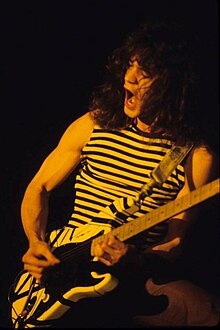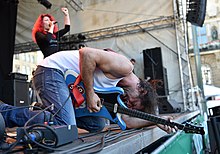Guitar solo
This article is written like a personal reflection, personal essay, or argumentative essay that states a Wikipedia editor's personal feelings or presents an original argument about a topic. (January 2019) |
This article needs additional citations for verification. (September 2014) |

A guitar solo is a
Guitar solos range from unaccompanied works for a single guitar to compositions with
Classical guitar
This section needs additional citations for verification. (June 2024) |

The
Of music written originally for guitar, the earliest influential composers stem from the classical period.[4] They include Fernando Sor (b. Spain 1778) and Mauro Giuliani (b. Italy 1781),[5] it is noted that their music can be seen to be potentially influenced by Viennese classicism. In the 19th century guitar composers such as Johann Kaspar Mertz (b. Slovakia, Austria 1806) were influenced by music written for the piano.[6] I Francisco Tárrega (b. Spain 1852) wrote more uniquely guitar music, incorporating stylized aspects of flamenco's Moorish influences into his romantic miniatures. This was part of late 19th century European trend towards musical nationalism.[7] Albéniz and Granados contributed to this movement as they wrote within the same time period.[8]
Some classical guitarists play concertos, which are solos written for performance with the accompaniment of an orchestra. Fewer classical guitar concertos have been written compared to concertos for multi-instrumental orchestras.[9] Some potentially notable ones could include Joaquín Rodrigo's Concierto de Aranjuez and Fantasía para un gentilhombre. In the 2000s, it has been noted that classical guitar is appearing more in classical music, as contemporary composers are increasingly writing guitar concertos.[10]
History
Composers of the Renaissance period who wrote for four course guitar include
Traditional and popular music
Blues, R&B and rock and roll
The term "guitar solo" often refers to
Howlin' Wolf, Muddy Waters, Willie Dixon, and Jimmy Reed played in Chicago in a style characterized by the use of electric guitar, sometimes slide guitar, harmonica, and a rhythm section of bass and drums.[15] In the late 1950s, a new blues style emerged on Chicago's West Side pioneered by Magic Sam, Buddy Guy and Otis Rush on Cobra Records.[16] The 'West Side Sound' had strong rhythmic support from a rhythm guitar, bass guitar and drums and as perfected by Guy, Freddie King, Magic Slim and Luther Allison was dominated by amplified electric lead guitar.[17][18] Other blues artists, such as John Lee Hooker had influences not directly related to the Chicago style. John Lee Hooker's blues is more "personal," based on Hooker's deep rough voice accompanied by a single electric guitar.
These and other blues guitarists as well as the fast-picking techniques derived from country and bluegrass inspired the appearance of many virtuoso blues rock fusion soloists, beginning in 1963 with Lonnie Mack's first major recordings.[19] Jimi Hendrix was a psychedelic guitarist, and a pioneer in the use of distortion and audio feedback in his music.[20] Through these artists and others, blues music influenced the development of rock music.[21] Another important blues rock guitar soloist in the 1960s and 1970s was Eric Clapton. In the early 1970s, the Texas rock-blues style emerged, which used guitars in both solo and rhythm roles (e.g., Stevie Ray Vaughan).
Rock
The earliest rock guitar solos, as exemplified by popular recordings of
Rock bands often have two guitarists, designated "

In classic

Solos can take place in the intro, such as "
The use of guitar solos in
Occasionally, a song contains a two-part guitar solo with both rhythm and lead guitar taking solos (e.g., "Master of Puppets" by Metallica), or dual solos with both lead and rhythm playing complementary solos—such as with Twisted Sister's "30", Iron Maiden's "Hallowed Be Thy Name", "The Trooper", Megadeth's "Holy Wars... The Punishment Due" or Deep Purple’s "Highway Star". Some rock bands use harmonized dual lead guitar solos as part of their signature sound, such as Wishbone Ash and Lovebites. This was first popularized by the Allman Brothers Band in their album At Fillmore East.
Bass guitar solos
The bass guitar is played through a
Players perform bass solos with a range of techniques, such as plucking or finger picking. In the 1960s,
Heavy metal bass players such as
Bass effects such as fuzz bass or wah-wah pedals to produce a more pronounced sound can be used when playing bass solos, hard rock and heavy metal bassists. Notably, Cliff Burton of Metallica used both distortion and wah-wah.[24] Bass guitar solos have a much lighter accompaniment than solos for other instruments due to the lower range of the bass. The bass guitar solo can also be unaccompanied or accompanied only by the drums.
See also
- Drum solo
- Solo (music)
- Air guitar - a form of dance and movement in which the performer pretends to play rock/heavy metal-style electric guitar solos
- Ostinato
- Lead guitar
Bibliography
- Atlas, Allan W. "Anthology of Renaissance music music in Western Europe, 1400-1600 " New York: W.W. Norton, 1998.
- Berg, Christopher. The Classical Guitar Companion New York, NY: Oxford University Press, 2019.
- Bohlman, Philip V. Focus: Music, Nationalism, and the Making of the New Europe. London: Routledge, 2011.
- ISBN 0-85229-511-1.).
{{cite book}}: CS1 maint: location missing publisher (link - O'Toole, Michael. John Williams : Changing the Culture of the Classical Guitar : Performance, Perception, Education and Construction Abingdon, Oxon: New York, NY : Routledge, 2019.
- Tomalin, Marcus. "Lutes, Vihuelas and Guitars—filling in Some Gaps." Early music 46, no. 4 (2018): 694–697.
- Randall Zwally. "William Kanengiser: Classical Guitar and Beyond." Notes 64, no. 1 (2007): 128–129.
References
- ^ "guitar | History, Types, & Facts". Encyclopedia Britannica. Retrieved 2020-10-27.
- ^ O'Toole, M. (2019). John Williams : changing the culture of the classical guitar : performance, perception, education and construction . New York, NY : Routledge. 135 - 140
- ^ "guitar | History & Facts". Encyclopedia Britannica. Retrieved 2019-04-29.
- ^ Randall Zwally. "William Kanengiser: Classical Guitar and Beyond." Notes 64, no. 1 (2007): 128–129.
- ^ Randall Zwally. "William Kanengiser: Classical Guitar and Beyond." Notes 64, no. 1 (2007): 128–129.
- ^ O'Toole, Michael. John Williams : Changing the Culture of the Classical Guitar : Performance, Perception, Education and Construction Abingdon, Oxon: New York, NY : Routledge, 2019.
- ^ "Musical Nationalism | Music Appreciation". courses.lumenlearning.com. Retrieved 2020-10-27.
- ^ Bohlman, Philip V., and Philip Vilas. Bohlman. Focus Music, Nationalism, and the Making of the New Europe 2nd ed. New York: Routledge, 2010.
- ^ O'Toole, Michael. John Williams : Changing the Culture of the Classical Guitar : Performance, Perception, Education and Construction Abingdon, Oxon: New York, NY : Routledge, 2019.
- ^ O'Toole, Michael. John Williams : Changing the Culture of the Classical Guitar : Performance, Perception, Education and Construction Abingdon, Oxon: New York, NY : Routledge, 2019.
- ^ Atlas, Allan W. "Anthology of Renaissance music music in Western Europe, 1400-1600 " New York: W.W. Norton, 1998.
- ^ Tomalin, Marcus. "Lutes, Vihuelas and Guitars—filling in Some Gaps." Early music 46, no. 4 (2018): 694–697.
- JSTOR 964862. Retrieved 23 March 2022.
- ^ "Top 25 Classical Guitarists". 6 December 2018.
- ^ Howlin' Wolf & Jimmy Reed interviewed on the Pop Chronicles (1969)
- ^ Koroma, pg. 49
- ^ "Blues". Encyclopedia of Chicago. Retrieved August 13, 2008.
- ^ C. Michael Bailey (October 4, 2003). "West Side Chicago Blues". All about Jazz. Retrieved August 13, 2008.
- ^ Mack augmented his blues solos with fast-picking country techniques, and set them to a rock beat. His early recordings are widely regarded as a critical milestone in the rise of the electric guitar's role to that of a lead voice in rock music. See, Wikipedia article on Lonnie Mack.
- ^ Garofalo, pgs. 224–225
- ^ "History of heavy metal: Origins and early popularity (1960s and early 1970s)". September 18, 2006. Retrieved August 13, 2008.
- ^ Describing all of these as "inherently simple": Brown & Newquist, Legends of Rock Guitar, Hal Leonard Publishing, 1997, at p. 21.
- ^ "A brief history of the bass guitar". guitarlessonspoway.com. Retrieved 2020-10-27.
- ^ Brewster, Will (11 August 2017). "GEAR RUNDOWN: CLIFF BURTON". Mixdown. Retrieved 2019-04-02.
